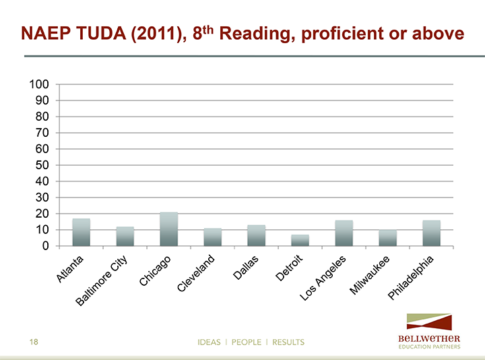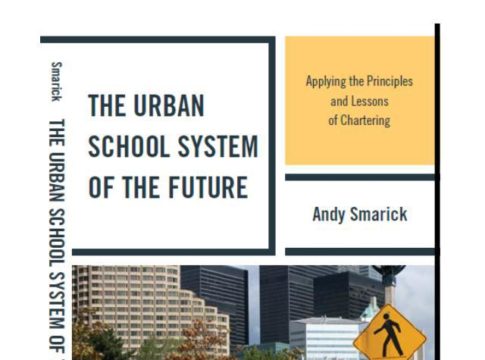I wrote this book because, first and foremost, I wanted our community to know that our activities don’t have to be dictated by decisions made a hundred years ago, especially when those decisions have led to consistently heartbreaking results.
Second, the solution is right in front of us—it’s at work every single day, in cities from coast to coast. We just need to take it from its limited application and scale it, which will take far less work than you might imagine. And it will allow us to do what should have been ages ago: bring an end to the failed urban district.
In the simplest terms, chartering should replace the urban district.
Namely, four systemic innovations that chartering introduced into public education should serve as the tools for managing a city’s portfolio of schools. This is a plan for continuous improvement.
Here a quick walk through how our thinking and activities need to change to realize the urban school system of the future.
First, we have to begin with a new guiding question. Instead of asking, “How do we improve the district?” which wrongfully assumes that the district must be the central actor, our new question should be, “How do we maximize the number of students in high-performing schools?”
This has important consequences. It gets us focused on school performance.
It also leads us to “sector agnosticism,” meaning we judge each school individually, without regard to who runs it. This is a “three-sector approach.” It shouldn’t matter if a school comes from the charter sector, the traditional public sector, or the private school sector. We should simply care about performance.
This levels the playing field. All are assessed based on their ability to run great schools.
The upshot is that the district is put on the same footing as a charter management organization. Both are simply central organizations that run schools. This is a conceptual demotion for the district.
But what comes next is the essential shift. Every school, including district-run schools, must have a performance contract with an authorizer. An operator can run its schools as it chooses but a separate entity assesses the performance of its schools.
Then the four systemic innovations of chartering are applied to the portfolio of schools:
- High-performing schools are helped to expand and replicate.
- Persistently failing schools are closed.
- New schools are regularly created.
- A diversity of offerings is maintained.
This is a continuous improvement cycle that happens year after year to ensure that we continually grow the number of high-performing seats
So what would this actually look like in practice?
Think of public education as the space holding a city’s portfolio of schools.
The district is just one segment of the portfolio. We also have a wide array of charter management organizations—some running one school, others running many.
There are also what I refer to as “PMOs” private school management organizations. Each could run an individual private school or a number of schools. Remember, in the urban school system of the future, we’ve stopped fighting about sector and now focus on quality, so private schools are a part of the portfolio.
Each school in the portfolio would have a contract with an authorizer. This goes for charters, district-run schools, and participating private schools.
A new city-wide office call the chancellor of city schools would then be responsible for implementing the four systemic innovations of chartering. The chancellor would be the portfolio manager. Its job is to ensure that we continuously grow the number of high-quality seats.
Now imagine that several CMOs are getting superb results. The chancellor would make sure they had access to facilities and human capital so they could create new campuses, grow enrollment, or add new grades.
If a CMO ran a persistently low performing school, the authorizer would close that school, shrinking the footprint of the CMO. If another ran several low-quality schools, the authorizer might bring the entire CMO to an end. The chancellor would help make sure those students had suitable replacement schools.
A PMO may run one low performing school. Though the authorizer can’t constitutionally close a private school, it should be able to remove it from the public system.
And if the district ran numerous failing schools, the authorizer would close them and shrink the market share of the district.
At the same time new schools, subject to a rigorous approval process, would be allowed to start.
The key lesson here is that the portfolio of schools would be fluid. It would evolve each year based on school quality.
This will not necessarily mean the end of the district. If it can run good schools, it will continue. But it loses its right to run low-performing schools. Do well, and thrive. Do poorly, and disappear.
Previous Charter Findings
Some of you might be wondering. “Wasn’t there a CREDO study several year ago showing that charter results were no better than district school results?”
This study looked at results across 16 states. It treated the charter sector as a monolith. But some of these places had bad authorizing practices, hostile practices, and more.
The real question is what happened in the places where the four systemic innovations were most faithfully implemented? If you follow smart chartering policies and practices, what can be accomplished?
The answer is extraordinary.
In New York City, Joel Klein recruited the best charter operators and gave them flexibility and facilities. He helped them to grow when they succeeded. He helped build a strong support ecosystem and closed low performing schools.
The researchers subsequently found that a student attending NYC charters throughout her K-8 career could nearly close the normal achievement gap between a Harlem student and a peer in an affluent suburb. Importantly, the same CREDO scholars who conducted the national analysis found that in NYC charter students were significantly outperforming their traditional public schools peers.
In Newark, two of the nation’s best CMOs were encouraged to expand and replicate. Low performers were closed charters. CREDO found that for every year a Newark student spent in a charter, she gained 7 additional months of learning in reading and a year of math; the researchers said these were “some of the largest learning gains we have seen to date.”
In New Orleans, the city with the system most similar to the one I recommend. Thanks to a remarkable reform ecosystem, the city is recruiting great operators, expanding high-performing schools, closing failing schools, and providing a wide array of supports. As a result nearly 90 percent of charter schools are performing at or above the traditional public school level. Since Katrina the city has nearly caught up with the state average in student proficiency. Last year, New Orleans had a higher graduation rate than the state and national average and just-released ACT scores show faster growth in New Orleans than in the state and the nation.
When implemented well, the urban school system of the future is getting results that the district system simply can’t seem to match.
Conclusion
I’m sure many of you have believed for some time that the urban district was broken and that it would never get the results we needed.
But you probably thought that it was essential and immortal, that it was public education. It would be with us forever, we had no choice, so we had to make do with what we had.
I hope now you see that’s not true. The urban district was created a long, long time ago, in and for a very different age. It doesn’t reflect our beliefs, and it doesn’t meet our needs. Despite the best efforts of great people and more money than we can count, it delivered poor results year after year after year.
Fortunately, we now know that it is dispensable. We can preserve public education while ridding ourselves of an organizational structure that doesn’t work.
We have the solution in front of us—a system based on chartering—that is generating the kinds of results that can make us proud.
Best of all, this new system is on its way. In city after city, the district is losing students. In New Orleans about 80 percent of kids are in charters. In DC and Detroit it’s more than 40%, in Kansas City and Flint it’s over a third; in St. Louis, Cleveland, Albany, and Indianapolis, it’s over a quarter.
Finally, at long last, we can get about the business of building the high-performing urban school system of tomorrow. We can direct our attention and resources to the future instead of the past. We can put our best people on our best opportunities, instead of our worst problems. We can cut ties with the mistakes of our predecessors and chart our own course.
The traditional urban school district is broken. It cannot be fixed.
But, thank goodness, it can be replaced.
-Andy Smarick
This blog entry first appeared on the Fordham Institute’s Flypaper blog.





